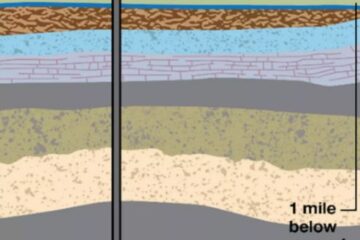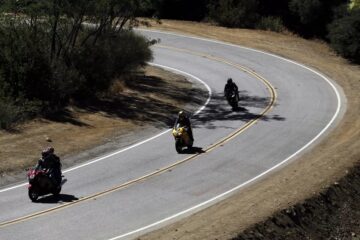Recycling in Los Angeles: Bin There, Doing That
Combining mechanization and hands-on labor, city program is giving new life to discards and sending less trash to landfills.
Source of this article – Los Angeles Times, December 5, 2005.
By James Ricci, Times Staff Writer
On a warm, sunny Tuesday morning, city recycle truck No. 36572 huffs and bucks through the alleys and streets of North Hollywood.
Behind the wheel on the right side of the cab, Ron Cole Jr. eyeballs the next blue bin on the street and pulls abreast of it. Tapping a video game-like control panel, he extends a mechanical grabber, grasps the bin and dumps its contents into the truck’s receiving well.
On a small black-and-white monitor connected to a camera at the mouth of the well, Cole checks to ensure each bin is empty. If it isn’t, he gives the bin a vigorous shake.
Then he sets it down and moves on.
Every week in Los Angeles, residents trundle some 800,000 blue recycling bins out to their curbs. By separating paper, plastic and glass from the rest of their trash, recyclers can feel they are contributing to an affluent society’s war against waste.
But how warranted are their feelings of virtuousness?
Does the mountain of newspapers, soup cans, mail-order catalogs, plastic drink bottles, credit card solicitations and broken toys picked up each week by Cole and his colleagues actually get reused?
A surprising amount of it does.
Each day, at plants that contract with the city, the primitive work of human hands combines with clever mechanization to successfully transform the city’s discards into industrial aggregates that become commodities once again.

OF A SORT: Workers at Sun Valley Paper Stock Inc. manually remove material that isn’t recyclable. The plant is among the contractors in L.A.’s recycling program. (Damon Winter / LAT)
The blue bin program, which costs about $14 million a year to run, has resulted in a significant reduction in the amount of trash the city sends to landfills.
In the late 1980s, before state law required recycling, Los Angeles buried all 1.6 million tons of waste it collected yearly from curbside. The total volume has remained about the same, but last year the city sent only about a million tons to landfills. The remainder, deposited in green bins (for yard waste) and blue bins, was recycled.
After three hours and 45 minutes of stop-and-go collections, truck No. 36572 is full. Cole heads for Sun Valley Paper Stock Inc. in Sun Valley.
Turning off San Fernando Road, he backs into one end of an open-faced building half a mile long and enters a din of ratcheting machinery and plastic bottles and jugs popping beneath the wheels of roaring bulldozers.
Here, Sun Valley Paper’s 62 line employees process about 6,000 tons a month from the city program.
Cole’s load weighs in at a little over 5 1/2 tons. It is slowly ejected from the truck onto the receiving floor, where a bulldozer shoves it against a tall heap of other trucks’ loads, ready for processing.
Eventually, the undifferentiated mass is loaded in a single layer onto two wide conveyors that ferry it up one story to a presorting line. There, 20 gloved, masked and hard-hatted workers pull out the obvious trash — bags of food waste tossed in the wrong bin and other garbage — which will be sent to a landfill.
They also pluck out large recyclables, such as corrugated cardboard, plastic toys and buckets and pieces of scrap metal. Each category has its own bin on the floor below.
The most common items incorrectly placed in the blue bins, plant manager Mike Hernandez said, are wood and drywall, both of which are pulled out and sent to landfills.
Hernandez, 45, started as a sorter at Sun Valley Paper 26 years ago. He says things are greatly improved now. “In those days,” he said, “we used to sort on the ground instead of up on the equipment. We didn’t have all this fantastic equipment back then. The work was pretty much all by hand. Now it’s much easier, more comfortable.”
The work is unskilled, Hernandez said, with the principal qualification for sorters being a willingness to show up faithfully for duty.
The plant uses a mix of temporary and permanent employees who make between $7 and $16 per hour. Good workers can be moved to areas where there’s a little more responsibility, he said, such as loading reclaimed items on trailers and assisting supervisors
There’s no getting around the fact, though, that a job at a recycling plant means spending the day with other people’s garbage.
Cole’s load is making its way through the line. What has survived the presort heads to the “news screen,” a row of large turning discs atop an incline.
The news screen spawns three separate streams of material: smaller fragments of trash and glass that fall immediately down to a conveyor belt; large pieces of newspaper that the discs move upward; and containers and smaller pieces of paper that tumble back down the incline onto their own conveyor line.
It’s a remarkably efficient process. Shaker screens separate dirt and tiny pieces of unusable glass and divert them to trash bins.
An air jet blows paper shreds into recovery bins. Metal is recovered with a magnet.
The glass passes into an optical sorter where an infrared light identifies remaining rocks, trash and other non-translucent objects and ejects them by air jet, leaving just the salable glass.
Newspapers have their own path, moving upward to another sorting line, where 20 workers pick over the swiftly moving debris by hand, removing such items as cereal boxes and the plastic grocery bags that are ubiquitous at nearly every phase of sorting.
The boxes will later be baled with other non-newsprint paper; the bags with other plastic bags.
The more valuable newsprint drops from the conveyors into two large bins and is conveyed to one of two balers that, with 4,000 pounds per square inch of pressure, form the paper into 1,400-pound bales.
Smaller pieces of paper — fliers, letter-size documents — and containers of all kinds — glass, plastic, aluminum or tin — are weeded out by gravity, falling onto a conveyor that leads to a second set of sorting discs that automatically separates the paper from the containers.
The mixed paper is formed by machine into 1,400-pound bales of its own.
The containers proceed to the “glass sort” station, where a single sharp-eyed worker picks intact bottles from the moving line and tosses them down one story into separate bins for amber, green and clear glass.
The remaining containers make their way into a magnetic trommel, a rotating drum that pulls empty tin cans from the mass. Cans that weren’t emptied before being tossed into the blue bins can’t be recycled and are dropped into a trash bin.
Then air jets propel the lighter containers, such as those made of plastic and aluminum, into a crusher-perforator where spiked wheels puncture and flatten plastic jugs and bottles.
The stream continues to a “light container sort line” where half a dozen women hand-remove and segregate, in succession, plastic food containers, milk and water jugs, colored plastic containers (such as those used for detergent and fruit juice) and soft-drink bottles.
The remaining material passes through an “eddy current” that neatly kicks out aluminum cans — the single most valuable recycling commodity — and scraps of aluminum foil.
The rest, theoretically, is trash. But just in case, what has survived is put through the entire process again. Typically about 80% percent of that is recovered as recyclable material.
Of the 6,000 tons Sun Valley Paper takes in each month, about 4,000 is actually recycled. The rest is trucked to landfills.
Newsprint and mixed paper account for nearly half of what is recovered at Sun Valley. Most of every category except glass is shipped abroad; Sun Valley’s biggest foreign customer is China.
The curbside program, which largely serves single-family houses, accounts for only a small percentage of the total waste — about 10 million tons — generated annually in Los Angeles. The rest comes from offices, businesses and multifamily dwellings.
Citywide, about 62% of waste is recycled, although only 40% of the waste picked up by the city curbside is recycled. The city has a goal of recycling 70% of the city’s total waste by 2020.
The reincarnations are numerous. Remanufacturing can turn old newspaper into newsprint again. Mixed paper can be turned into cereal boxes, milk cartons into stationery, soda bottles into carpeting and clothing, plastic bags into building material, old wine bottles into new wine bottles.
Some of it, in whatever form, may even find its way back to North Hollywood, be put to a new use, then get discarded in blue bins.
On a future Tuesday, it may even rendezvous again with Ron Cole Jr.


